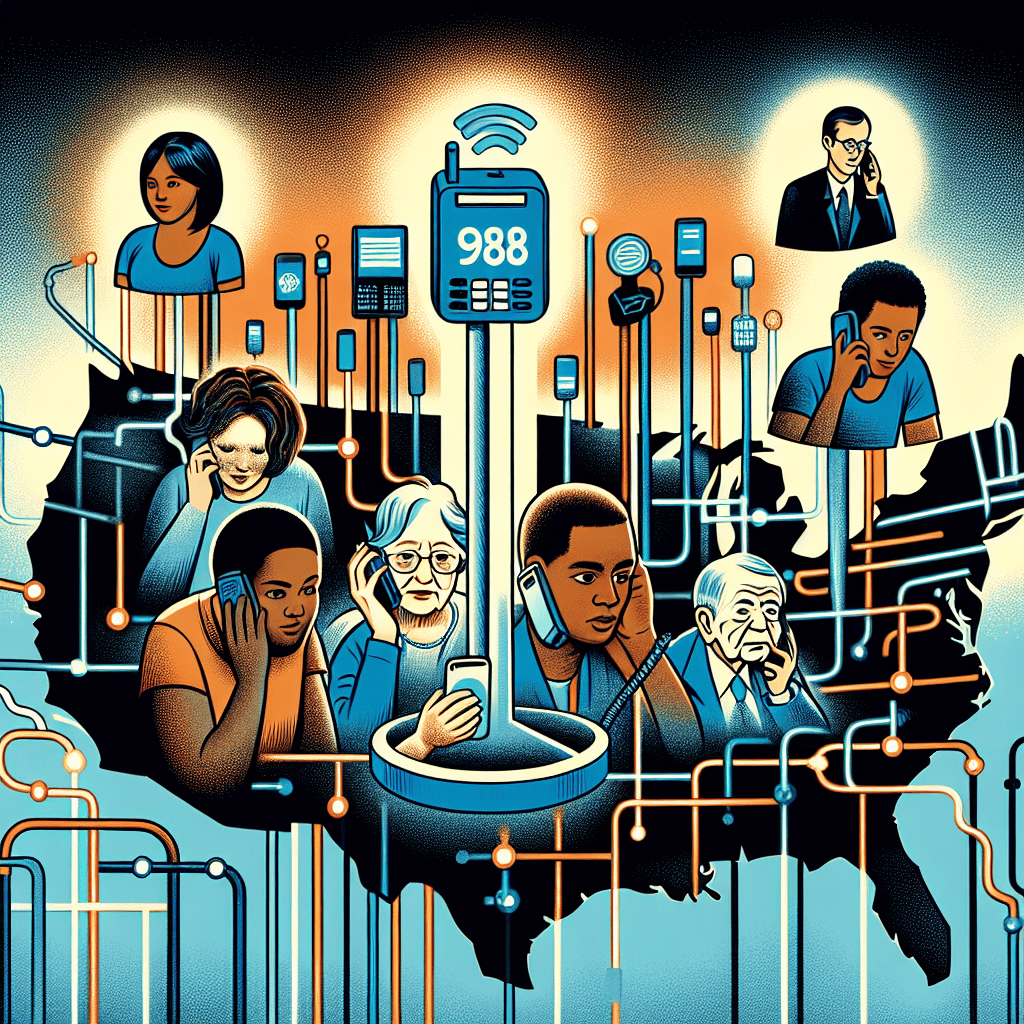FCC to Implement Georouting for 988 Lifeline to Improve Local Service Access

The Federal Communications Commission (FCC) has announced a significant enhancement to the 988 Suicide & Crisis Lifeline by implementing georouting technology. This initiative aims to improve local service access, ensuring that individuals in crisis receive timely and appropriate support. The introduction of georouting is a pivotal step in addressing the growing mental health crisis in the United States, providing a more efficient and effective response system. This article delves into the intricacies of georouting, its potential impact on the 988 Lifeline, and the broader implications for mental health services.
Understanding Georouting and Its Role in Crisis Response
Georouting is a technology that uses geographic information to route calls to the most appropriate service center based on the caller’s location. In the context of the 988 Lifeline, georouting will enable calls to be directed to local crisis centers, ensuring that individuals receive support from professionals familiar with local resources and cultural nuances.
The implementation of georouting in the 988 Lifeline is expected to address several challenges currently faced by the system. One of the primary issues is the mismatch between callers and crisis centers, which can lead to delays in service and a lack of localized support. By routing calls based on geographic location, georouting can significantly reduce these mismatches, improving the overall efficiency of the crisis response system.
Moreover, georouting can enhance the quality of care provided to individuals in crisis. Local crisis centers are often better equipped to address the specific needs of their communities, as they have a deeper understanding of local resources, cultural factors, and potential barriers to care. This localized approach can lead to more personalized and effective support for individuals in crisis.
In addition to improving the efficiency and quality of care, georouting can also help to alleviate the burden on overworked crisis centers. By distributing calls more evenly across the network of crisis centers, georouting can prevent any single center from becoming overwhelmed, ensuring that all calls are handled promptly and effectively.
The Current State of the 988 Lifeline and Its Challenges
The 988 Lifeline, launched in July 2022, is a critical component of the United States’ mental health crisis response system. It provides a direct line to trained crisis counselors, offering support to individuals experiencing suicidal thoughts, mental health crises, or emotional distress. However, despite its importance, the 988 Lifeline faces several challenges that hinder its effectiveness.
One of the primary challenges is the high volume of calls received by the Lifeline. Since its launch, the 988 Lifeline has experienced a significant increase in call volume, reflecting the growing demand for mental health services. This surge in demand has placed considerable strain on crisis centers, leading to longer wait times and, in some cases, missed calls.
Another challenge is the lack of uniformity in the quality of care provided by different crisis centers. While some centers are well-equipped to handle the volume and complexity of calls, others may lack the necessary resources or training. This disparity can result in inconsistent support for individuals in crisis, undermining the overall effectiveness of the 988 Lifeline.
Additionally, the current system of routing calls based on area codes rather than geographic location can lead to mismatches between callers and crisis centers. This can result in delays in service and a lack of localized support, as crisis counselors may not be familiar with the resources and cultural factors relevant to the caller’s location.
These challenges highlight the need for improvements to the 988 Lifeline, and the implementation of georouting is a promising solution. By addressing these issues, georouting can enhance the efficiency and effectiveness of the crisis response system, ensuring that individuals in crisis receive the support they need.
Case Studies: Georouting in Action
To understand the potential impact of georouting on the 988 Lifeline, it is helpful to examine case studies of georouting in action. Several states and organizations have already implemented georouting technology in their crisis response systems, providing valuable insights into its benefits and challenges.
One notable example is the state of Arizona, which implemented georouting for its crisis response system in 2019. The state faced significant challenges in providing timely and appropriate support to individuals in crisis, particularly in rural areas. By implementing georouting, Arizona was able to route calls to the most appropriate crisis center based on the caller’s location, improving the efficiency and effectiveness of its crisis response system.
The results of Arizona’s georouting implementation have been promising. The state has reported a significant reduction in wait times for crisis calls, as well as an increase in the quality of care provided to individuals in crisis. Additionally, the use of georouting has helped to alleviate the burden on overworked crisis centers, ensuring that all calls are handled promptly and effectively.
Another example is the National Suicide Prevention Lifeline, which has implemented georouting for its text and chat services. By routing messages based on geographic location, the Lifeline has been able to provide more localized support to individuals in crisis, improving the overall quality of care. The success of this implementation has provided valuable insights into the potential benefits of georouting for the 988 Lifeline.
These case studies demonstrate the potential of georouting to enhance the efficiency and effectiveness of crisis response systems. By examining these examples, we can gain a better understanding of the benefits and challenges of georouting, informing the implementation of this technology for the 988 Lifeline.
Potential Benefits of Georouting for the 988 Lifeline
The implementation of georouting for the 988 Lifeline is expected to bring several benefits, enhancing the efficiency and effectiveness of the crisis response system. These benefits include improved call routing, enhanced quality of care, and reduced burden on crisis centers.
One of the primary benefits of georouting is improved call routing. By routing calls based on geographic location, georouting can ensure that individuals in crisis are connected with the most appropriate crisis center. This can reduce delays in service and improve the overall efficiency of the crisis response system.
Another benefit is enhanced quality of care. Local crisis centers are often better equipped to address the specific needs of their communities, as they have a deeper understanding of local resources, cultural factors, and potential barriers to care. By routing calls to local crisis centers, georouting can lead to more personalized and effective support for individuals in crisis.
Additionally, georouting can help to alleviate the burden on overworked crisis centers. By distributing calls more evenly across the network of crisis centers, georouting can prevent any single center from becoming overwhelmed, ensuring that all calls are handled promptly and effectively.
These benefits highlight the potential of georouting to enhance the efficiency and effectiveness of the 988 Lifeline, providing timely and appropriate support to individuals in crisis. By addressing the challenges currently faced by the system, georouting can improve the overall quality of care and ensure that individuals receive the support they need.
Challenges and Considerations for Implementing Georouting
While the implementation of georouting for the 988 Lifeline offers significant potential benefits, it also presents several challenges and considerations. These include technical challenges, privacy concerns, and the need for coordination among crisis centers.
One of the primary technical challenges is the need for accurate and reliable geographic information. Georouting relies on precise location data to route calls to the most appropriate crisis center. Ensuring the accuracy and reliability of this data is critical to the success of georouting, as errors in location data can lead to misrouting and delays in service.
Another challenge is privacy concerns. The use of geographic information for call routing raises questions about the privacy and security of caller data. It is essential to ensure that georouting is implemented in a way that protects the privacy of individuals in crisis, while still providing the necessary information for effective call routing.
Additionally, the implementation of georouting requires coordination among crisis centers. Crisis centers must work together to ensure that calls are routed appropriately and that individuals receive the support they need. This requires effective communication and collaboration among crisis centers, as well as the development of standardized protocols for call routing.
These challenges highlight the need for careful planning and consideration in the implementation of georouting for the 988 Lifeline. By addressing these challenges, we can ensure that georouting is implemented effectively, enhancing the efficiency and effectiveness of the crisis response system.
Conclusion: The Future of Crisis Response with Georouting
The implementation of georouting for the 988 Lifeline represents a significant step forward in improving local service access for individuals in crisis. By routing calls based on geographic location, georouting can enhance the efficiency and effectiveness of the crisis response system, ensuring that individuals receive timely and appropriate support.
While the implementation of georouting presents several challenges, these can be addressed through careful planning and consideration. By ensuring the accuracy and reliability of geographic information, protecting the privacy of caller data, and coordinating among crisis centers, we can ensure that georouting is implemented effectively.
The potential benefits of georouting for the 988 Lifeline are significant. By improving call routing, enhancing the quality of care, and reducing the burden on crisis centers, georouting can improve the overall quality of care for individuals in crisis. This represents a critical step forward in addressing the growing mental health crisis in the United States, providing a more efficient and effective response system.
As we look to the future, the implementation of georouting for the 988 Lifeline offers a promising opportunity to enhance the efficiency and effectiveness of crisis response systems. By leveraging this technology, we can ensure that individuals in crisis receive the support they need, improving outcomes and saving lives.





